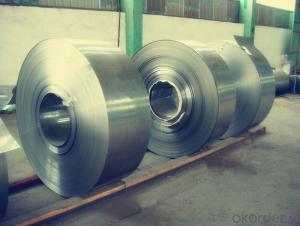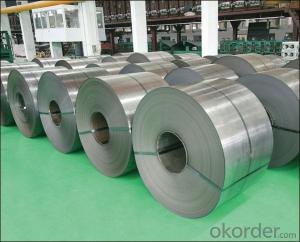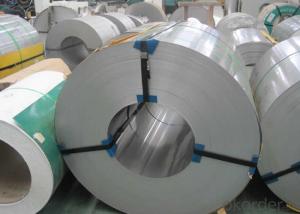Hot Rolled Stainless Steel Coil 201 No.1 Finish
OKorder Service Pledge
OKorder Financial Service
You Might Also Like
Hot Rolled Stainless Steel Coil 201 No.1 Finish
Hot Rolled Stainless Steel 201 half copper Chemical Composition(%) | |||||||
C | Si | Mn | P | S | Ni | Cr | Cu |
0.1 | 0.5 | 10 | 0.04 | 0.01 | 1.20/1.30 | 13.00/14.00 | 0.8/1.0 |
Grade: | 200 Series | Standard: | JIS,AISI,ASTM,GB,DIN | Thickness: | 2.5/3.0/4.0mm |
Width: | 485/510/550/610/1010/1240mm | Place of Origin: | Shanghai China (Mainland) | Brand Name: | CNBM |
Model Number: | 201 | Technique: | Hot Rolled | Application: | Industrial tubes/kitchen/bath |
Certification: | ISO | THK: | 2.5/3.0/4.0mm | Face: | No.1 |
Usage: | tubes/kitchen/bath | Origin: | CHINA | ||
Packaging Detail: For customer's requirement
Delivery Detail:10-30days
201 Hot Rolled Stainless Steel Coil Specifications
THK:2.3/2.5/3.0/4.0mm
Width:485/510/550/610/1010/1240mm
Face:No.1
201 Hot rolled stainless steel Coil Application
Stainless steel is a production which not easy rust,acid resistance and corrosion resistance,so it is widely
used in light industry,heavy industry,daily necessities and the decoration industry.201 hot rolled stainless steel coil, use to produce cold rolled stainless steel coil and stainless steel tube, pipe.
201 Hot Rolled Stainless Steel Coil
Strength Of Extension:100,000 To 180,000 Psi;
Yield Strength:50,000 To 150,000 Psi
Elongation :55 To 60%;
Modulus Of Elasticity:29,000,000 Psi;
Density :.280lbs/Cubic Inch(7.93g/Cm3)
- Q: What are the benefits of using stainless steel strips?
- There are several benefits of using stainless steel strips. Firstly, stainless steel is highly resistant to corrosion, making it ideal for use in various environments, including outdoor and marine applications. Secondly, stainless steel strips offer excellent strength and durability, ensuring long-term performance and reliability. Additionally, stainless steel is easy to clean and maintain, making it a hygienic choice for industries such as food processing and healthcare. Lastly, stainless steel strips have an attractive appearance, making them suitable for decorative purposes as well.
- Q: What are the common uses of stainless steel strips in the chemical filtration industry?
- Stainless steel strips are commonly used in the chemical filtration industry for various purposes such as structural support in filter systems, as filtration media for removing impurities from liquids or gases, as components in filter elements, and as screens or sieves for separating particles of different sizes. Their corrosion resistance, durability, and high temperature resistance make them ideal for handling corrosive chemicals and maintaining the efficiency of filtration processes in the industry.
- Q: Can stainless steel strips be bent or shaped?
- Yes, stainless steel strips can be bent or shaped. Stainless steel is a highly malleable material, meaning it can be easily manipulated into various forms and shapes. With the proper tools and techniques, stainless steel strips can be bent, curved, or formed into a desired shape. The bending or shaping process typically involves using specialized machines such as press brakes, rollers, or mandrels, which apply force to the stainless steel strip to achieve the desired shape. Additionally, the thickness and tempering of the stainless steel strip can also affect its bendability and shapeability. Overall, stainless steel strips offer a great amount of flexibility and can be easily manipulated to fit various applications and designs.
- Q: What are the common uses of stainless steel strips in the pharmaceutical packaging industry?
- Stainless steel strips have several common uses in the pharmaceutical packaging industry. One of the primary uses is in the production of packaging containers and components. Stainless steel strips are used to manufacture various types of containers such as vials, ampoules, and syringes. These containers need to be made from a material that is corrosion-resistant, durable, and can maintain the sterility of the pharmaceutical products. Stainless steel, with its high resistance to corrosion and ability to withstand high temperatures, makes it an ideal choice for ensuring the safety and integrity of the packaged drugs. In addition to containers, stainless steel strips are also utilized in the production of packaging components such as lids, caps, and closures. These components play a crucial role in maintaining the quality and freshness of pharmaceutical products. Stainless steel's resistance to rust and its ability to provide an airtight seal make it suitable for ensuring the integrity of the packaged medications. Furthermore, stainless steel strips are utilized in the construction of pharmaceutical machinery and equipment. Pharmaceutical manufacturing processes often involve the use of heavy machinery that requires durable and corrosion-resistant materials. Stainless steel strips are commonly used in the fabrication of machine parts, conveyor systems, and packaging equipment to ensure their longevity and reliability. Another common use of stainless steel strips in the pharmaceutical packaging industry is for labeling and identification purposes. Stainless steel strips can be engraved or etched with important information such as batch numbers, expiration dates, and drug identification codes. This ensures that the pharmaceutical products can be accurately tracked, traced, and identified throughout the packaging and distribution process. Overall, stainless steel strips offer numerous benefits in the pharmaceutical packaging industry. Their corrosion resistance, durability, and ability to maintain sterility make them an essential material for manufacturing containers, components, machinery, and labeling in the pharmaceutical packaging sector.
- Q: Can stainless steel strips be magnetized?
- Yes, stainless steel strips can be magnetized. While stainless steel is generally considered non-magnetic, certain types of stainless steel can exhibit magnetic properties when subjected to specific conditions. The magnetic properties of stainless steel are influenced by its chemical composition, heat treatment, and manufacturing process. Austenitic stainless steel, which is the most common type, is generally non-magnetic. However, it can become slightly magnetic when cold worked or deformed, such as in the case of stainless steel strips. On the other hand, ferritic and martensitic stainless steels are magnetic in their annealed or hardened state. These types of stainless steel strips can be easily magnetized and retain magnetism even after the external magnetic field is removed. Therefore, it is important to consider the specific type of stainless steel strip before determining its magnetic properties.
- Q: What are the common uses of stainless steel strips in the automotive suspension systems?
- Various purposes necessitate the common usage of stainless steel strips in automotive suspension systems. One of the primary applications lies in the manufacturing of leaf springs, which form an integral part of said suspension system. Leaf springs possess the responsibility of absorbing shocks and preserving the stability of the vehicle. Stainless steel strips offer ideal material qualities for leaf springs, including excellent durability, resistance to corrosion, and high tensile strength. Moreover, the production of coil springs heavily relies on the utilization of stainless steel strips. Coil springs play a crucial role in supporting the vehicle's weight and providing a smooth ride. Stainless steel's exceptional strength-to-weight ratio enables the creation of lightweight coil springs capable of withstanding heavy loads and maintaining their shape over time. Additionally, sway bars or stabilizer bars are fabricated using stainless steel strips. These bars are responsible for minimizing body roll and enhancing the vehicle's handling during cornering. The exceptional strength and resistance to deformation exhibited by stainless steel make it a suitable material for sway bars, thus ensuring optimal performance and longevity. Furthermore, suspension brackets, hangers, and other components that necessitate high strength and resistance to corrosion find application of stainless steel strips. These components are vital for maintaining the structural integrity of the suspension system and ensuring the safe operation of the vehicle. In conclusion, the exceptional mechanical properties, corrosion resistance, and durability of stainless steel strips make them widely employed in automotive suspension systems. They play a vital role in enhancing the performance, stability, and safety of vehicles on the road.
- Q: Can stainless steel strips be used in aerospace manufacturing?
- Yes, stainless steel strips can be used in aerospace manufacturing. Stainless steel is known for its durability and resistance to corrosion, which makes it an ideal choice for various aerospace applications. It is commonly used in the construction of aircraft structures, such as fuselage frames, wing components, engine mounts, and landing gear. Stainless steel strips offer excellent strength-to-weight ratio, making them suitable for applications that require high strength and stiffness while minimizing weight. Additionally, stainless steel can withstand extreme temperatures and is highly resistant to fatigue, making it a reliable material for aerospace manufacturing.
- Q: Are stainless steel strips suitable for decorative etching?
- Indeed, stainless steel strips prove to be fitting for decorative etching purposes. The versatility of stainless steel allows for the etching and engraving of elaborate and intricate designs and patterns. Its polished and smooth surface lends itself perfectly to the creation of detailed and visually captivating decorative etchings. Moreover, stainless steel exhibits exceptional durability and resistance to corrosion, ensuring the longevity of the etched designs. This quality has made stainless steel strips a favored option for a multitude of decorative applications, including signage, jewelry, art pieces, and architectural elements.
- Q: Can stainless steel strips be used in marine vessel construction?
- Indeed, stainless steel strips find practical application in the construction of marine vessels. Offering exceptional resistance to corrosion, stainless steel emerges as an optimal alternative for marine purposes. Withstanding the corrosive nature of saltwater, stainless steel resists rusting and deterioration. In fact, stainless steel strips can be effectively employed in multiple sections of a marine vessel, encompassing the hull, deck, fittings, and equipment. Its robustness, strength, and unwavering resistance to corrosion render stainless steel a dependable material for crafting marine vessels capable of enduring the harsh oceanic conditions.
- Q: What is the typical thickness range for stainless steel strips?
- The typical thickness range for stainless steel strips can vary, but it is generally between 0.015 inches (0.38 mm) to 0.1875 inches (4.76 mm).
Send your message to us
Hot Rolled Stainless Steel Coil 201 No.1 Finish
OKorder Service Pledge
OKorder Financial Service
Similar products
Hot products
Hot Searches
Related keywords






























